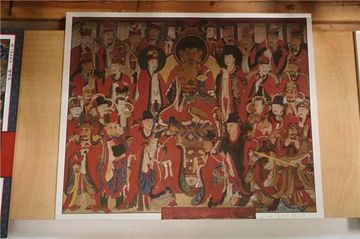양주 청련사 지장시왕도
| 양주 청련사 지장시왕도 Buddhist Painting of Cheongnyeonsa Temple, Yangju (Ksitigarbha Bodhisattva and Ten Underworld Kings) |
|
 양주 청련사 지장시왕도, 국가문화유산포털, 문화재청. |
|
| 대표명칭 | 양주 청련사 지장시왕도 |
|---|---|
| 영문명칭 | Buddhist Painting of Cheongnyeonsa Temple, Yangju (Ksitigarbha Bodhisattva and Ten Underworld Kings) |
| 한자 | 楊州 靑蓮寺 地藏十王圖 |
| 주소 | 경기도 양주시 장흥면 권율로 169 |
| 지정(등록) 종목 | 경기도 유형문화재 제341호 |
| 지정(등록)일 | 2018년 9월 10일 |
| 분류 | 유물/불교회화/탱화/기타 |
| 시대 | 조선시대 |
| 수량/면적 | 1점 |
| 웹사이트 | 양주 청련사 지장시왕도, 국가문화유산포털, 문화재청. |
해설문
국문
시왕은 저승에서 죽은 사람을 재판하는 열 명으로 진광대왕, 초강대왕, 송제대왕, 오관대왕, 염라대왕, 변성대왕, 태산대왕, 평등대왕, 도시대왕, 오도전륜대왕을 말한다. 죽은 날부터 49일까지는 7일마다 그 뒤에는 백일, 1년, 2년 때까지 망자를 심판한다.
양주 청련사 지장시왕도는 긴 병풍을 배경으로 지장보살과 사람이 죽은 뒤에 간다는 영혼의 세계 또는 사람이 죽은 뒤에 심판을 받는 곳인 명부 세계의 주요 권속이 그려져 있다. 명부 세계는 지장보살과 도명존자, 무독귀왕의 지장삼존이 중심을 이루고 주위에는 시왕, 판관, 녹사, 사자, 장군, 우두옥졸, 마두옥졸 등으로 구성된다. 홀을 든 시왕이 의자에 앉아 있는 모습은 특이한데, 이 모습은 남양주 흥국사 <지장시왕도>(1868년)에서도 비슷한 도상을 볼 수 있다. 조성 연대를 알 수 없지만, 이 불화는 19세기 후반에 조성된 것으로 추정되며 지장시왕도의 한 유형과 신앙 내용을 알 수 있는 불화이다. 일부 화기가 남아있어 시주자와 기원 내용을 알 수 있는데, 이에 따르면 여러 상궁과 일반 신도들이 장수를 위해 이 불화를 발원했다. 양주 청련사와 관련된 기록에 의하면 불화는 다른 사찰에서 조성한 후 청련사로 옮겨진 것을 알 수 있다.
영문
Buddhist Painting of Cheongnyeonsa Temple, Yangju (Ksitigarbha Bodhisattva and Ten Underworld Kings)
This painting depicting Ksitigarbha Bodhisattva and his retinue, including the Ten Underworld Kings, is presumed to have been made in the late 19th century. The painting is said to have been made at a different temple and then moved to Cheongnyeonsa Temple. According to the inscription at the bottom of the painting, it was funded by the ladies of the royal court and private individuals praying for longevity.
Ksitigarbha is a bodhisattva who took on the responsibility of rescuing unfortunate beings from hell and vowed to postpone Buddhahood until all beings are saved from the world of suffering. The Ten Underworld Kings preside over the judgment of the dead. In Buddhism, it is believed that upon one’s death, the deceased receives judgment every seven days for 49 days, then once on the 100th day, and again on the first and second anniversaries of death.
Ksitigarbha is depicted seated on a pedestal in the center with a long folding screen behind him. Standing to either side of him are Demon King Wudu and Monk Daoming. Demon King Wudu is believed to expel the evil from people’s hearts, while Daoming was a Chinese monk who is said to have accidentally experienced the afterlife and returned to the world of the living to teach about what he had seen. Gathered around them are the Ten Underworld Kings, judges, officials, underworld messengers, generals, and jailers. Unlike most paintings of this kind where the Ten Underworld Kings are depicted standing, in this painting they are seated on chairs and hold scepters. Such a depiction of the Ten Underworld Kings can be also seen in the Ksitigarbha Bodhisattva and Ten Underworld Kings painting of Heungguksa Temple in Namyangju, painted in 1868.
영문 해설 내용
이 불화는 지장보살, 시왕과 권속들을 그린 그림으로, 19세기 후반에 조성된 것으로 추정된다. 다른 사찰에서 그려진 뒤 청련사로 옮겨졌다고 한다. 그림 하단에 남아 있는 기록에 따르면 이 불화는 왕실의 상궁들과 일반 신도들이 장수를 기원하며 발원했다.
지장보살은 저승세계인 명부에서 고통받는 중생을 모두 구원하기 전에는 성불하지 않겠다고 맹세한 보살이다. 시왕은 저승에서 죽은 자의 죄를 심판하는 10명의 왕을 말한다. 불교에서는 망자가 죽은 날부터 49일까지는 7일마다, 그 뒤에는 백일, 1년, 2년이 되었을 때 죄를 심판받는다고 여겨진다.
긴 병풍을 배경으로 화면 중앙에는 지장보살이 대좌 위에 앉아 있고, 양옆에는 무독귀왕과 도명존자가 서 있다. 무독귀왕은 사람들의 악한 마음을 없애준다는 귀신 왕이고, 도명존자는 사후세계를 경험하고 이승에 돌아와 자신이 본 바를 세상에 알린 스님이다. 지장삼존 주위에는 시왕, 판관, 녹사, 사자, 장군, 옥졸 등이 있다. 일반적으로 시왕도에서 시왕은 서 있는 모습으로 표현되는데, 이 그림에서는 시왕이 홀을 들고 의자에 앉아 있다. 이러한 도상은 1868년에 그려진 남양주 흥국사의 지장시왕도에서도 볼 수 있다.